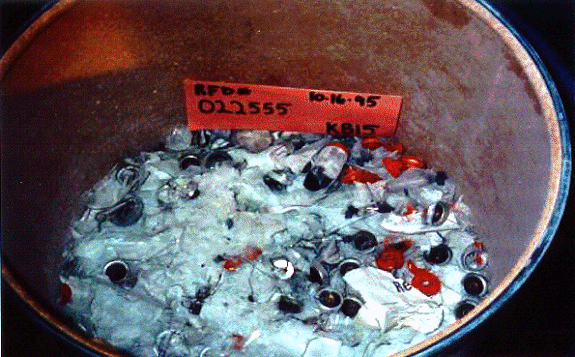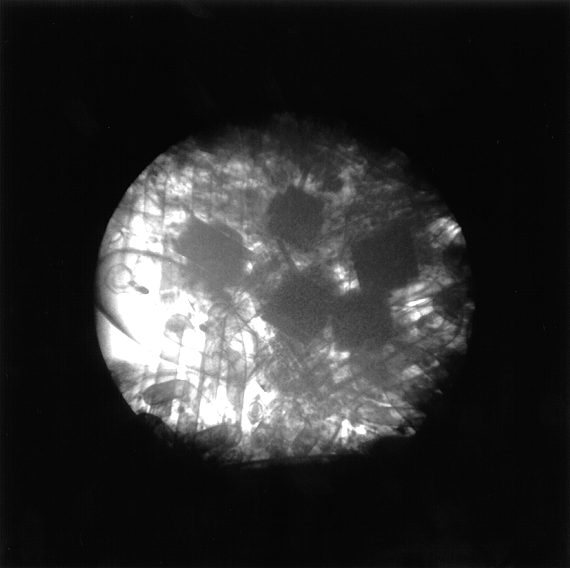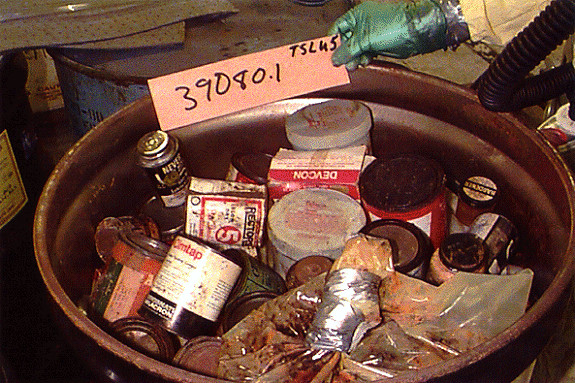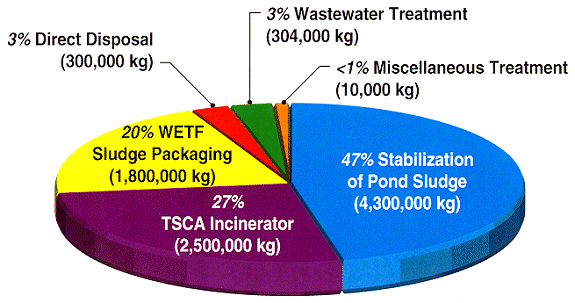
THE OAK RIDGE SITE TREATMENT PLAN EXPERIENCE:
THE EARLY YEARS AND BEYOND
Charles H. Estes and Lance J. Mezga
Lockheed Martin Energy Systems, Inc.
Joy L. Sager
U. S. Department of Energy
Oak Ridge Operations Office
ABSTRACT
Because of the lack of treatment capacity, the Department of Energy (DOE) is storing approximately 24 million kilograms of mixed low-level waste in long-term storage at the Oak Ridge Reservation (ORR). These wastes are stored in violation of the storage prohibitions under the land disposal restrictions under the Resource, Conservation, and Recovery Act. The Federal Facility Compliance Act requires federal agencies such as DOE to bring these mixed wastes into compliance under state issued orders. On September 26, 1995, the Tennessee Department of Environment and Conservation issued a Commissioner's Order to the DOE Oak Ridge Operations Office. The order required DOE to meet specific milestones and deliverables under a Site Treatment Plan (STP).
This paper describes the progress achieved during the period after the issuance of the ORR STP. The program to comply with the STP includes further characterization of mixed wastes; the use of on-site facilities such as the East Tennessee Technology Park Toxic Substances Control Act Incinerator and wastewater treatment facilities; treatment and disposal at existing commercial mixed waste treatment facilities; and the planned award of private sector contracts under the Oak Ridge Broad Spectrum Procurement. Successes and lessons learned from characterizing, treating, and disposing of waste and developing documents to meet milestones and deliverables will be discussed. The paper will also discuss future activities and issues including the integration with the Accelerated Cleanup Plan, impacts from potential future budget reductions, and state concerns.
INTRODUCTION
The Oak Ridge Reservation (ORR) is comprised of three major federal facilities: the Y-12 Plant, the Oak Ridge National Laboratory, and the East Tennessee Technology Park ( ETTP, formerly the K-25 Site). These are operated for the Department of Energy (DOE) by Lockheed Martin Energy Systems and Lockheed Martin Energy Research. While the Y-12 Plant's mission of separation of U-235 has diminished, its focus today is on dismantling nuclear weapons components, providing special production support, and serving as a manufacturing, technology, and demonstration center. The Oak Ridge National Laboratory (ORNL) provides extensive research and development in energy production and related technologies. Activities include reactor and accelerator development and operation, production and sale of radioactive and stable isotopes, and environmental and health research. Prior to 1986, the ETTP was an uranium enrichment production facility. ETTP's present mission is environmental restoration, waste management, decontamination and decommissioning, and site reindustrialization.
The operations on the ORR have resulted in a wide variety of wastes generated with a range of physical matrices and contaminants. Treatment capabilities on-site are limited to wastewater treatment facilities and thermal treatment at the ETTP Toxic Substances Control Act Incinerator (TSCAI). As a result of the shipment of wastes containing small amounts of residual radioactivity to commercial hazardous waste facility, wastes defined as mixed waste, radioactive and hazardous, received more scrutiny prior to off-site treatment or disposal in 1991. This resulted in large quantities of mixed waste remaining on-site in violation of the Resource Conservation and Recovery Act (RCRA) land disposal restrictions (LDR). On October 6, 1992, the Federal Facility Compliance Act was passed requiring all federal facilities to complete a plan to treat mixed waste to the LDR treatment standards. The Tennessee Department of Environment and Conservation (TDEC) approved a Site Treatment Plan (STP) for the treatment of mixed waste on the ORR on October 6, 1995.
The ORR STP identified approximately 30 million kg of mixed low-level waste that require treatment. Wastes in the STP were divided into categories associated with treatment capabilities and schedule and were given a preferred treatment option. Categories consisted of on-site wastewater treatment facilities, on-site thermal treatment at the TSCAI, commercial stabilization of low-level mixed sludges, and further characterization and/or technology adaptation of remaining low-level mixed waste for commercial treatment.
This paper describes the strategy for implementing the STP, the results to date, and expectations for the program.
STP DEVELOPMENT AND IMPLEMENTATION
The STP was developed during a series of working meetings between TDEC, DOE, and LMES staff in the spring and summer of 1995. An inventory was developed for the mixed waste and grouped into waste categories in Figure 1. The first step of the strategy was to identify mixed waste inventory that could be assigned to on-site treatment facilities and then develop an aggressive schedule to treat the identified inventory. Wastes that could not be treated on-site either required further characterization prior to treatment or required commercial technology adaptation or facility modification. Schedules for wastes that were believed to meet waste acceptance criteria of commercial treatment facilities were developed based on time required to obtain characterization data and funding priority. Schedules for the remainder of the wastes that could not be treated on-site were developed based on the placing of a contract(s) under the DOE Broad Spectrum Procurement for mixed waste.

Figure 1. Oak Ridge Reservation mixed waste inventory.
Milestones and commitments for treatment and disposal of all legacy mixed waste form the basis for the MLLW plans and schedules described in the ORR Accelerated Cleanup Plan that was issued for comment in May, 1997 and revised in November, 1997. The schedules for work off of MLLW inventory in the Accelerated Cleanup Plan change as planned budget profiles in outyears change due to different planning assumptions. The system of commitments that the ORR STP has adopted, three-year enforceable milestones and out-year target completion dates, provides some flexibility in matching changing funding plans and the need to have firm enforceable milestones. The experience with updating the Accelerated Cleanup Plan to reflect new funding profiles has been that, so far, funding changes can be accommodated within the three-year period of enforceable milestones and lengthening schedules in the outyears to accommodate lower overall funding and still be consistent with the letter of the STP.
After issuance of the TDEC Commissioner's Order for the STP, LMES assembled a management team to implement and report progress on the STP milestones and commitments. The LMES Mixed Waste Program Team was established and divided into project teams to manage specific scopes of work. Project teams included: Order and Agreement Team to coordinate and report progress and inventory status; Process Residues Team to treat and dispose all treatment process residuals such as wastewater treatment sludges at commercial facilities; Aqueous Waste Team to treat all drummed or tanked aqueous mixed waste at on-site treatment facilities; Incinerable Mixed Waste Team to treat all incinerable inventoried mixed waste at the on-site Toxic Substances Control Act Incinerator (TSCAI); and the Balance of Inventory Team to treat and dispose of the remaining mixed waste such as labpacks, debris, soils, sludges, etc. not covered under the other projects. Each team then developed specific projects for each waste stream or waste grouping under the project. Project support, schedules, and budgets were then developed.
AQUEOUS WASTE TREATMENT
The inventory of aqueous mixed waste originally consisted of approximately 406,000 kg of wastewaters from laboratories and process operations stored in containers and tanks. Appropriate treatment included neutralization for corrosive-only waste, precipitation for metals contaminated aqueous waste, neutralization followed by precipitation for corrosive aqueous waste contaminated with metals, biological treatment for organics and nitrates, and chemical oxidation for aqueous cyanide waste.
The primary facility used to treat the containerized legacy mixed waste is the Y-12 Central Pollution Control Facility. Other facilities utilized are the Y-12 West End Treatment Facility, ETTP Central Neutralization Facility, and the ORNL Process Waste Treatment Plant. These permit-by-rule facilities are designed and operated to treat large quantities of dilute aqueous waste in tanker loads or piped directly to the facility. Figure 2 shows the ETTP Central Neutralization Facility. A significant challenge for the project has been to provide bulked quantities of the containerized aqueous waste which will meet the acceptance criteria or NPDES permit levels. To accomplish this, populations of aqueous waste are developed using screening techniques such as analyzing for ICP metals and measuring pH "like" populations. Sampling and jar tests are performed to provide data to develop treatment strategies aimed at specific facilities. As of December 31, 1997, approximately 304,000 kg of containerized aqueous mixed waste has been treated through these facilities. Treatment of this waste was accomplished without any violations of NPDES permits. The STP requires 160,000 kg of mixed aqueous waste to be treated in FY 1998. As the project nears completion in the next two years, many smaller aqueous waste streams will be encountered that will require significant pretreatment which may require involvement from the state regulators to modify NPDES permits or pretreatment requirements. Many of the remaining aqueous waste to be treated contain high concentrations of cyandide and mercury. The CPCF upgrade will provide pretreatment of these wastes. The remaining inventory of aqueous waste will be treated by September 30, 1999, as required under the STP.

Figure 2.
INCINERABLE LIQUIDS AND SOLIDS
The inventory of mixed waste incinerable liquids and solids consists of 43 waste streams or groupings originally totaling approximately 1.7 million kg. The designated treatment for this waste is the ETTP TSCAI. The TSCAI is a 25 foot long rotary kiln with a secondary combustion chamber and an ionizing wet scrubber. It's operating temperature is above 1500° F to provide for the destruction of both RCRA and PCB contaminated wastes. The average residence time for liquids is a few seconds in the secondary chamber while the residence time in the kiln for solids is approximately an hour. The incinerator operates under a Tennessee RCRA permit and a TSCA authorization from the EPA. Figure 3 is a photograph of the TSCAI.

Figure 3.
The projects success hinges on the adequate and timely characterization of mixed waste incinerable solids and liquids to meet the waste acceptance criteria of the incinerator and the incinerator burn plan. A characterization program is in place to identify, sample, and analyze populations of mixed waste that have the potential to meet the TSCAI waste acceptance criteria. This information is then used to develop strategies such as bulking, blending, and feed rates. As of December 31, 1997, all STP milestones have been met with approximately 1.9 million kg of incinerable liquid mixed waste treated under the STP and 590,000 kg of incinerable solid mixed waste treated under the STP. The remaining STP milestone is to complete treatment of the approximately 1.8 million kg of incinerable liquids and solids inventory in FY 1998. Challenges to meeting this milestone includes resolving problems, related to beryllium concentrations in liquids, waste acceptance criteria for various radionuclides and solids feed size limitations.
PROCESS RESIDUES
The inventory of mixed waste process residues under the STP originally consisted of approximately 21.8 million kg of residues from on-site wastewater treatment facilities and the TSCAI. Treatment originally planned for these process residuals was primarily commercial off-site stabilization such as grouting or chemical stabilization. The DOE Transportable Vitrification System (TVS) was also expected to provide some treatment capability.
After further characterization, two process residue waste streams, the Y-12 West End Treatment Facility (WETF) and the ETTP Central Neutralization Facility (CNF) have demonstrated the potential to meet the LDRs without further treatment and only require treatment to remove free liquids to meet the waste disposal acceptance criteria. Processing of the WETF sludges includes pumping the sludges from 500,000 gallon tanks and adding a dewatering agent as waste is placed into 21st Century containers for shipping. As of December 31, 1997, approximately 1.8 million kgs of sludge have been processed and shipped to Envirocare for disposal. Figure 4 and 5 are photographs of the WETF sludge process. Treatment of the CNF sludge includes recontainerization of the drummed CNF sludge with the addition of dewatering agent. As of December 31, 1997, approximately 150,000 kgs of CNF sludge has been repackaged for shipment for disposal. For FY 1998, 900,000 kg of WETF sludge and the remaining 400,000 kg of CNF sludge are planned for processing and disposal. Treatment of 900,000 kg of WETF sludges are planned to be treated each year through FY 2008.

Figure 4

Figure 5
In order to demonstrate and evaluate the applicability to ORR waste streams and the technology's cost effectiveness, the TVS was operated to treat a small quantity of mixed waste as required by the STP. In August and September 1997, the TVS operated under a temporary authorization from the State of Tennessee to vitrify mixed waste. Approximately 7,300 kg of ETTP Pond Waste Management Project sludge and CNF sludge was treated by the TVS during that period. Results indicate that the TVS provides effective treatment for these wastes. A further evaluation of the unit's cost effectiveness is being completed. The ETTP Pond Waste Management Project unstabilized sludges are shipped and grouted at Envirocare prior to disposal. As of December 31, 1997, approximately 4.3 million kgs of the sludge have been treated and disposed. Treatment of 1.4 million kg per year of this sludge is planned through FY 2006. The remaining sludge waste streams will be stabilized using treatment contracts with commercial facilities. TSCAI residuals such as kiln brick, sludge, and ash have also been characterized and determined to meet LDR and the disposal facility WAC. As of December 31, 1997, approximately 213,000 kg of these residuals have been disposed.
BALANCE OF INVENTORY
The remaining inventory of mixed waste under the STP consists of approximately 78 waste streams or groupings and are managed under the Balance of Inventory Project. Soils, sludges, debris, and labpacks are the primary waste types in the Balance of Inventory. Originally, this project had an inventory of about 6.3 million kg. DOE and LMES have issued a Request For Proposal to treat these and other DOE wastes under a DOE Broad Spectrum Procurement on January 16, 1998. Contracts for treatment are expected to be awarded in May 1998. Although the inventory has grown while treatment capability is developed, some waste streams such as crushed glass and labpacks are currently being processed for treatment or disposal. Also, several thousand kg of small waste streams such explosives, beryllium, and elemental mercury and metals have been deactivated, recycled, or disposed. Seven thousand kg of aerosol cans and compressed gases have been treated. The compressed gases were treated by recontainerization, venting or neutralization using a gas recontainerization skid to process gas cylinders.
The crushed bulb waste stream consists of approximately 102,000 kg. Previous characterization found that crushed fluorescent bulbs qualified as "newly identified waste" under RCRA. These are wastes that pass the Extraction Procedure Toxicity Test but fail the newer Toxicity Characteristics Leaching Procedure. Until April 1998, newly identified waste are exempted from meeting the LDR treatment standards. Therefore, the fluorescent crushed bulbs can be segregated for direct disposal. A project was developed to segregate nonconforming items such as end caps, filters, and liquids from crushed and intact fluorescent and incandescent bulbs. A number of options including dumping the waste containers and physically sorting or screening each drum were evaluated. To minimize worker exposure to mercury, it was determined that a real time radiography (RTR) unit at the ORNL would be utilized to view and characterize the drums checking for the presence of nonconforming items. As of January 31, 1998, approximately 70,000 kg of crushed fluorescent bulbs have been shipped for disposal. The remaining inventory of crushed fluorescent bulbs is targeted for shipment by February 28, 1998. The drums with non-conforming items that cannot be removed will be stored for commercial treatment. In the near future, drums of crushed incandescent bulbs will be processed to segregate and remove end caps that have lead solder making the item characteristically hazardous for lead. The incandescent glass will be disposed as sanitary or low-level waste while the end caps will be encapsulated. Figure 6 and 7 show a typical drum of crushed bulbs and a photograph of a crushed glass drum using RTR.

Figure 6

Figure 7
Labpacks at ORNL and Y-12 are being processed in FY 1998. ETTP labpacks will be processed in FY 1999. Approximately 70,000 kg of labpacks are currently in storage on the ORR. Labpack waste is stored both as on-the-shelf items for items that have been more recently generated and as containerized labpacks for older items. The labpack project will first attempt to certify on-the-shelf items as no-added radioactive contamination (NARC) to allow items to be sent for treatment at commercial off-site treatment facilities. Items that cannot be NARC certified will be bulked for treatment at the TSCAI or on-site wastewater treatment facilities. Those items that cannot be bulked will be packaged and stored for future treatment at a commercial mixed waste treatment facility. Figure 8 is a photograph of a typical containerized labpack.

Figure 8
The remaining waste streams under the Balance of Inventory Project will be characterized and treated through commercial mixed waste treatment contracts. The DOE Broad Spectrum Procurement will be the primary contract vehicle. The RFP for the procurement was released on January 16, 1998. Five categories of waste are included for treatment under this national procurement. One category has been reserved for small businesses only. The five categories were developed to cover the range of treatment technologies required to treat the mixed waste under the Balance of Inventory. The categories include a combination of waste matrices (e.g., soils, sludges, and debris) and contaminants (e.g., PCBs and RCRA metals and organics). A fixed price five year contract will be awarded for each category. Contracts will require a First Article Test that must be completed within two years of contract award and prior to issuance of task order quantities. Under a contract, DOE will be responsible for characterizing waste to meet a treatment facility's waste acceptance criteria, providing Department of Transportation compliant containers, and loading containers. Successful vendors will be responsible for pick up of waste containers at staging areas, transporting the waste, treating the waste to meet LDRs and disposal facility waste acceptance criteria, characterizing treated waste and residuals, and transporting treated waste and residuals for disposal.
Twelve prospective vendors have submitted qualification documentation under the procurement. Qualified vendors will be invited to provide technical details at oral presentations to be held in March 1998. Vendors found to be technically qualified will be invited to submit business proposals. Final contract awards are expected to be made in May 1998. DOE is required to complete National Environmental Policy Act (NEPA) documentation for each contract awarded. The NEPA documentation must be completed within two years of the contract award and prior to the First Article Test.
CONCLUSIONS
DOE and the LMES Mixed Waste Program Team have successfully planned and implemented a program to manage, treat, and dispose of legacy mixed waste on the ORR. This was accomplished through:
Through the success of the team and matrixed support, all milestones and commitments under the STP were completed on or ahead of schedule and under cost. Figure 9 provides a distribution by treatment type for the approximately 9.2 million kg of mixed low-level waste that have been treated or disposed under the program as of December 31, 1997. Plans are in place for the treatment and disposal of 23.5 million kg of mixed low-level waste in the next eight years as shown in Figure 10.

Figure 9

Figure 10